Choosing mushroom cultivation as a business, you are on the path to organizing your profitable business. It will take a little effort from the owner to understand the basics of the technology of this production. What you need to know to open a mushroom business, we will tell in this article. 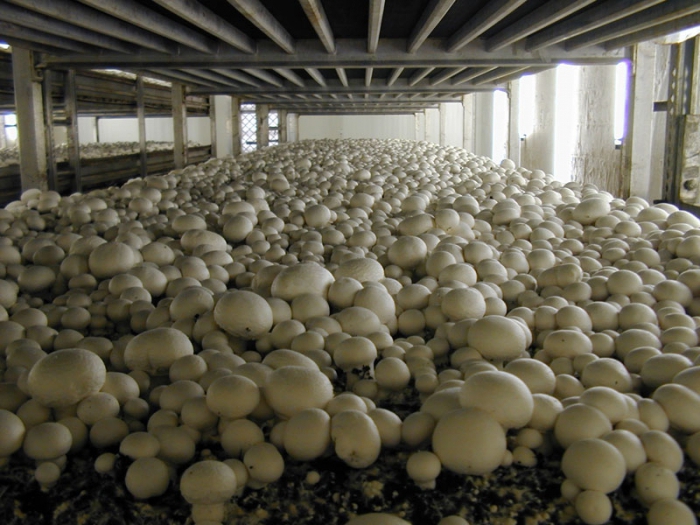
general information
Growing champignons as a business is a good opportunity to earn extra money. Such a business idea has several advantages:
- The cultivation of this product does not require constant attention and presence. Your employment will be partial.
- In most cases, the cultivation of oyster mushrooms and mushrooms does not require special knowledge and skills.
- The materials necessary for the organization of production, for the most part, are quite simple. What may cause difficulty in manufacturing is recommended to be purchased in finished form.
Growing champignons as a business is a chance to start earning additional funds. Here the main word is “additional”. Since it is quite difficult to turn mushroom production into an independent source of income. Those who are just thinking about how to do this type of business should know some of the main difficulties that they will encounter.
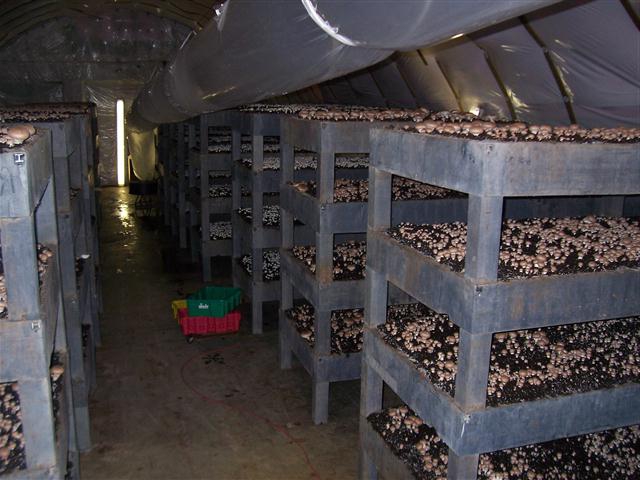
Where to begin?
The first step is to identify markets. To produce large volumes, you need to find a buyer on them and preferably not one. This will require the conclusion of contracts with large firms, factories, retail chains. This in itself is quite problematic.
In addition, a stable high level of productivity should be maintained. And this is not so simple: mushrooms, just like vegetables and fruits, can be affected by diseases and parasites. Therefore, beginners should consider this type of business as a source of additional income.
We will tell you in detail about how to grow champignons and oyster mushrooms. Perhaps some tips will help you understand this topic a little better.
Technology for growing oyster mushrooms
Oyster mushrooms are considered one of the popular types of mushrooms for production. This is due to the fact that the technology for growing oyster mushrooms is one of the simplest. The mushroom grows both in open space and indoors. If you plan to use the second option, then the crop can be obtained all year round. For business, this method is best suited.
Equipment and materials
First you need to decide on the choice of premises. It can be a greenhouse, a special room, a barn, a basement. The place must be dry and clean. Walls and floors are recommended to be treated with bleach solution. This is necessary to disinfect the space. After this, ventilate the room well. One room is needed for the germination of the mycelium, and the other for the mushroom growth stage.
After preparing the premises, you need to make a substrate. For this, straw, sunflower husk, sawdust of non-coniferous species of trees or a mixture of any of the above materials are perfect. They need to be crushed well (into dust) and pasteurized (that is, steamed with hot water and cool).
Now the substrate needs to be laid in bags (polyethylene) layers. Between them, the mycelium of the fungus is laid, which is purchased in specialized stores. Make holes in the bags, the diameter of which will be approximately 1.5-2 cm. Arrange them every 15-20 cm.
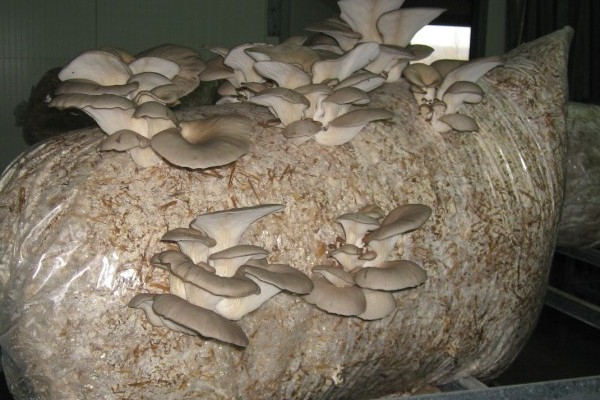
Climatic conditions
Place the bags in a closed, dark room. The air temperature in it should be about 22-25 degrees, humidity - about 95%. After 25-30 days, transfer the plastic bags to the second room, the temperature in which should be an order of magnitude lower - about 12-18 degrees.
The technology for growing oyster mushrooms requires that the room in which the bags will be kept for the second half of the time be constantly ventilated and moistened. This is necessary so that carbon dioxide does not accumulate in the room. In order not to resort to complex technologies, you can use a simple method. It is enough to put several buckets of water in the room and make the air circulate using a conventional fan.
As indicated above, the air temperature should not exceed 18 degrees. Keep humidity at 95%. In the room must be present lighting that would work for 12 hours a day. For this, fluorescent lamps are suitable.
Important! When working in a room with germinating mushrooms, wear a gauze bandage or respirator. This is necessary so that the oyster mushroom spores do not penetrate the respiratory tract. They can cause severe coughing or allergic reactions. If you are engaged in the production of oyster mushrooms on a large scale, then the use of such remedies is mandatory!
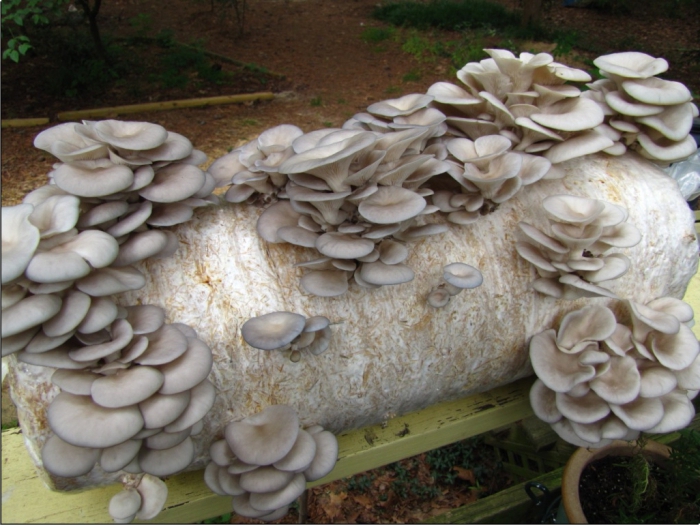
Sample calculations
The above recommendations can be used to create a production business plan. Oyster mushrooms are collected at the rate of 3 kg with 10 kg of substrate. From one bag you can get 1-2 crops, after which its contents need to be replaced. In a year, the substrate is renewed approximately 4-5 times, that is, 1 time in 2-3 months.
Experts say that one square meter of such a "plantation" is able to bring from 80 to 100 kg of mushrooms per year. As you can see, such mushroom cultivation at home is a simple and uncomplicated business. Starting small and gaining a constant market, you can increase production.
The technology of growing champignons at home
Excellent taste and the ability to grow champignon at home made it the most famous and widely used in the world. It is enough to familiarize yourself with the technology of its production in order to get a crop of fresh, selected and environmentally friendly mushrooms several times during the year.
Where to begin?
First you need to determine the room where you plan to grow champignons. For this, a barn, a greenhouse, a basement, a garage and even a balcony can come up. Like oyster mushrooms, champignons love high humidity, good ventilation and moderate temperature condition. Light is an important condition, but not the main one. The best temperature for mushroom growth is from 12 to 20 degrees and air humidity in the range of 50-55%. For production, you will need shelving, plastic boxes for planting, fans and thermometers to monitor the temperature of the substrate and air.
Composting
Experts recommend starting the cultivation of mushrooms at home with the preparation of compost. Unlike oyster mushrooms, additional materials will be required here. Take this issue responsibly, because nutritious soil for champignons is the key to a high yield. If it is cooked correctly, then you will get mushrooms in the amount of 20% of the compost volume.
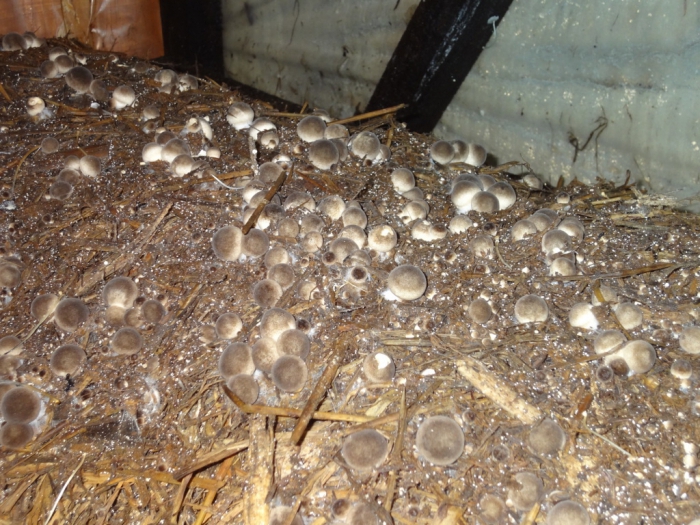
Components
There are many formulas for preparing nutritious soil. But there are components whose presence in compost is mandatory. All mixtures are made from manure. Horse riding is considered the best, but manure of pigs, cows, birds and sheep will also be effective. The second required component is straw or hay. They should be fresh and not ripened.
In addition to these materials, various fertilizers are placed in the compost: beet or potato tops, sunflower husk, beer pellet or other organic waste.In addition, the presence of nitrogen-containing components is necessary for a good mixture. For example, urea or ammonium sulfate.
Additives such as bone meal, cotton processing waste, and bran will also be useful. Mandatory is the presence of mineral elements - gypsum, chalk or superphosphate. Here is one of the most common formulas: for 100 kg of horse manure, 2.5 kg of gypsum, 50 kg of winter straw (chopped) and 15 kg of dried manure are required.
Manufacturing process
During the production of nutrient soil, it is necessary to pasteurize it. First, you should mix the manure with ground straw and leave for fermentation. During it, the mixture warms up to 50-60 degrees. As soon as the desired temperature is reached, and for this it will take 4-6 days, it is necessary to interrupt. This involves thoroughly mixing the mixture and adding nutrients to it.
Approximately 5-6 interruptions are required with a break between them of 2-5 days. All stages take approximately 20-25 days, after which a ready-made substrate for champignons is obtained. After the last mixing, the compost should be allowed to warm up to 60 degrees, and after the ammonia smell ceases to emit from it, put it in specially prepared boxes for mushrooms. As soon as the temperature of the compost drops to 24-25 degrees, the mycelium is placed in it. The depth of its sowing should not be more than 10 cm.
Climatic conditions
During the germination period, an important point is the preservation of sufficient air humidity and substrate temperature, which should not exceed 30 degrees. After planting the mycelium, compost should be covered with newsprint or film. Regular wetting of the substrate is the basis for the full growth of mushrooms. But it must not be watered, but sprayed. In addition, do not forget to constantly moisten the walls and floor of the room to increase air humidity.
Gobting
Champignon production is divided into several stages: preparation of the substrate, planting of mycelium and hobbing. The latter consists in pouring a layer of soil on compost, the thickness of which should not exceed 3-4 cm. It should be relatively loose, poor and have a neutral reaction. A mixture of peat with chalk or loamy soil is best suited. During this period, the temperature of the substrate should be in the range of 20-22 degrees, and the air temperature - 13-16 degrees.
Harvesting
Somewhere 20 days after the last stage (hobbies), it’s time to harvest. It lasts from 1 month to two. Mushrooms appear "waves", after each compost must be watered. Mushrooms are harvested without a knife, manually. To do this, you need to carefully unscrew the mushroom. Harvest completely without residue. This will quickly cause a new “wave” of growth and save new mushrooms from the attack of pests.
After the harvest is over, the compost should be removed, and the racks and boxes should be disinfected. In addition, throughout the entire stage of growing mushrooms, periodically treat the room with bleach or a solution of potassium permanganate. Pests and diseases like a humid environment and tend to multiply in it with a vengeance, and this will be detrimental to future champignons.
Business costs
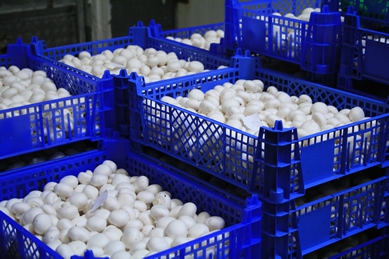 According to various sources, the profitability of the mushroom and oyster mushroom business ranges from 30 to 50%. This difference is explained by differences in production volumes, microclimatic parameters of the premises, transportation costs, energy costs, as well as labor and material resources.
According to various sources, the profitability of the mushroom and oyster mushroom business ranges from 30 to 50%. This difference is explained by differences in production volumes, microclimatic parameters of the premises, transportation costs, energy costs, as well as labor and material resources.
Before you start a similar business on a large scale, evaluate the level of expenses. The direct costs of organizing our own production of mushroom cultivation include the costs of the purchase of manure, chicken manure, straw, mineral additives (or the purchase of ready-made compost).
This also includes expenses for the purchase of consumables: containers, plastic film, seed mycelium.In addition, it is necessary to take into account the costs of fuel and lubricants, rent, electricity, utilities and payroll. This is not a complete list of expenses. Therefore, at the initial stages, you can limit yourself to small volumes, the production of which is easy to establish at home.
Finally
When choosing mushroom cultivation as a business, you need to understand that this is a process that will require time and knowledge from you. But it is enough to do the procedure once in a small amount to understand the technique and gain experience. In the future, you will not think about how to grow champignons.
Business will allow you not only to earn extra money, but also to enjoy the production process itself. With the right approach, you can get from 10 to 15 kg of mushrooms from 1 square meter of substrate. It is profitable to sell champignons and oyster mushrooms in winter and spring, when the demand for this product is especially great.
